- Army
- Air Defense Systems
- Anti-tank systems and vehicles
- Armored Vehicles
- Armoured personnel carriers
- Artillery Vehicles and Weapons
- Command Post
- Communication Vehicles and Systems
- Electronic Warfare
- Engineer | Maintenance Vehicles
- Infantry Fighting Vehicles
- Main Battle Tanks
- Missiles
- Tactical and Logistic Vehicles
- Radars
- Unmanned Systems
- Weapons
- Navy
- Air
Stormer HVM
Stormer HVM Starstreak High-Velocity Missile
Short-range mobile air defense missile system - United Kingdom
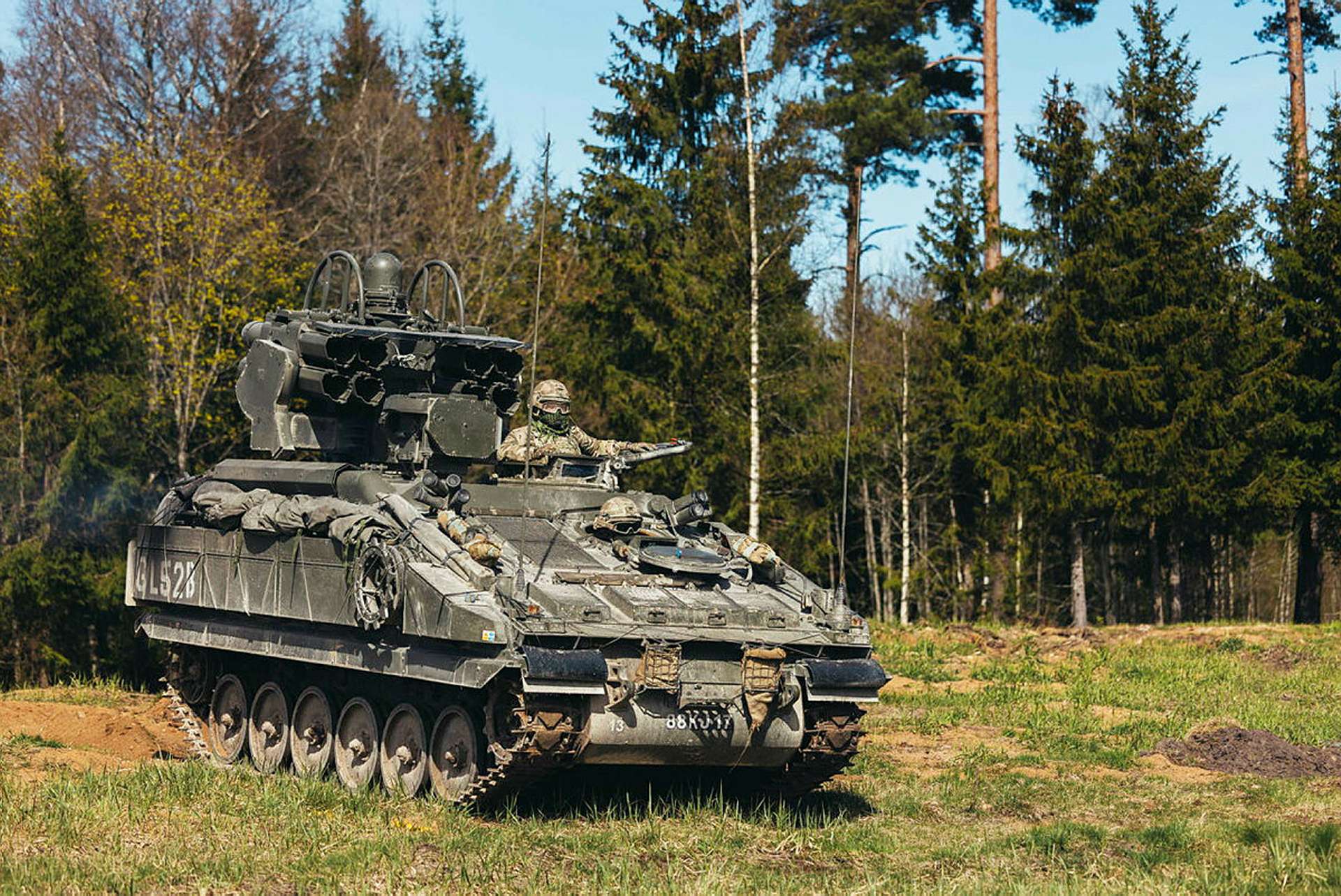
Description
The Stormer HVM (High Velocity Missile) is a British mobile short-range air defense system, designed to provide a mobile, rapid-response anti-aircraft capability. It is based on the Alvis Stormer armored vehicle platform and is equipped with the Starstreak High-Velocity Missile system. The primary role of the Stormer HVM is to protect ground forces and key installations from low-flying aircraft, helicopters, and UAVs (Unmanned Aerial Vehicles) The Stormer HVM has been an important part of the British Army's air defense capabilities since the 1990s. It was developed as a response to the need for a mobile and effective short-range air defense system that could protect ground forces and key installations from low-flying aircraft and helicopters. The Stormer HVM is still in service with the British army and it was also exported to Oman. On Monday, April 25, 2022, the British Secretary of Defense announced that the United Kingdom would provide military aid to the country following the Russian invasion. As part of this aid, an undisclosed number of Stormer tracked armored vehicles fitted with the Starstreak HVM air defense missile system will be sent. In January 2024, it was announced that the British army had deployed Stormer HVM in Saudi Arabia to counter Houthi rebels' missile and drone attacks.
Stormer HVM variants:
- No variants at this time.
Technical Data
| Armament |
|
The Stormer HVM is fitted with the Starstreak missile weapon station armed with two blocks of four Starstreak missiles ready to fire. Another batch of 12 missiles is stored in the vehicle. The turret allows for 360-degree rotation, enabling the crew to rapidly acquire and engage targets from any direction. The turret also houses missile guidance and fire control systems. Two smoke grenade dischargers are mounted on each side at the front of the hull. The roof of the vehicle is fitted with an air defense alerting device (ADAD), supplied by Thales (formerly Pilkington) Optronics. The ADAD is an infrared thermal imaging surveillance system that is used by close air defense units, to detect hostile aircraft and helicopter targets and direct weapon systems into the target area. Operating as an infrared search and tracking system in the 8 - 14 micron waveband, the alerter is designed to operate against low and fast-moving fixed-wing aircraft, as well as the latest generation of attack helicopters. The ADAD has a target acquisition range of 18 km for Fighter Ground Attack (FGA) targets and 8 km for helicopters.
|
 |
| Close view of Stormer HVM Starstreal missile turret. |
| Missile |
| The Starstreak High-Velocity Missile (HVM) is a British short-range surface-to-air missile system designed to engage low-flying aircraft, helicopters, and unmanned aerial vehicles (UAVs). Its unique features and technical capabilities make it one of the fastest and most effective short-range air defense systems in the world. The Starstreak missile employs a unique three-dart warhead design. Upon reaching close proximity to the target, the missile separates into three sub-munitions, or darts, each with its own explosive charge. This design increases the likelihood of successfully engaging and destroying the target. Each of the three darts carries a small but powerful tandem-charge warhead designed to penetrate the target's outer skin or armor before detonating its main explosive charge. This feature enhances the missile's lethality against armored aircraft and helicopters. The missile is capable of reaching speeds up to Mach 3.5, making it one of the fastest short-range surface-to-air missiles in the world. Its high speed reduces the reaction time for enemy aircraft and increases the missile's ability to intercept fast-moving targets. It has an effective range of approximately 7 kilometers, providing short-range air defense coverage for ground forces and key installations. The Starstreak missile uses a combination of laser guidance and a two-stage solid rocket motor. The operator tracks the target using a sighting system and directs the missile with a laser beam. This "beam-riding" guidance method ensures high accuracy and minimizes the risk of countermeasures, such as electronic jamming, affecting the missile's guidance. |
| Design and protection |
|
The Stormer HVM is based on the Alvis Stormer armored vehicle platform, which is a tracked, lightweight, and highly mobile vehicle. The design of the Stormer consists of three main parts with the driver at the left front of the hull, the engine compartment to the right, and a troop compartment at the rear. The hull is made of all-welded aluminum armor to provide protection against the firing of small arms and artillery shell splinters. The vehicle has a crew of three including a driver, a commander, and a gunner. The Stormer HVM offers protection for its crew against small arms fire and artillery shell splinters. The vehicle's armor is made of aluminum, which provides a balance between weight and protection. However, it is important to note that the Stormer HVM is not designed to withstand direct hits from heavy weapons or anti-tank missiles, as its primary role is to provide mobile air defense rather than engage in frontline combat.
|
| Mobility |
| The power pack of the Stormer HVM is composed of a Cummins 6B-275 six-cylinder diesel engine, which generates 250 hp at 2,600 rpm, and is connected to a David Brown Engineering T303 cross-drive automatic transmission that features an integrated steering system. This engine provides the vehicle with sufficient power for rapid acceleration and sustained high speeds, which are essential for quick deployment and repositioning during air defense operations. The torsion bar suspension system features six dual rubber-tired road wheels on each side, with the drive sprocket located at the front and the idler at the back. Two track-return rollers are included, and a lightweight steel covering protects the upper portion of the track to minimize dust. The Stormer HVM armored vehicle is capable of achieving a top road speed of approximately 80 km/h, making it highly mobile for a tracked vehicle. As for range, the Stormer HVM has a fuel capacity of around 454 liters and a combat range of approximately 600 km on roads. The off-road range will be lower due to increased fuel consumption resulting from the more challenging terrain. |
| Combat Equipment |
| The standard equipment of the Stormer HVM includes communication systems that allow the crew to maintain contact with other air defense units and higher command. This facilitates coordination, target prioritization, and overall situational awareness on the battlefield. The vehicle is also equipped with an NBC (Nuclear, Biological, and Chemical) protection system ensuring crew safety and operational capability in the event of an NBC attack or a contaminated environment. The Stormer HVM is equipped with an advanced sighting system that includes day/night capabilities, often featuring thermal imaging for low-light conditions. Some systems may also include a laser rangefinder for precise distance measurement, ensuring accurate missile guidance. |
Specifications
| Armament | Armor |
| Eight Starstreak surface-to-air missiles | Protection against the firing of small arms and artillery shell splinters |
| Country users | Weight Vehicle |
| Oman, United Kingdom, Ukraine | 13,000 kg |
| Designer Country | Speed Vehicle |
| United Kingdom | 80 km/h |
| Combat Equipment | Range Vehicle |
| Communication systems, day/night vision, laser range finder, tracking and detection systems, NBC protection system | 600 km |
| Crew | Dimensions Vehicle |
| 3 | Length: 5.6 m; Width: 2.8 m; Height: 3.4 m |
Details View
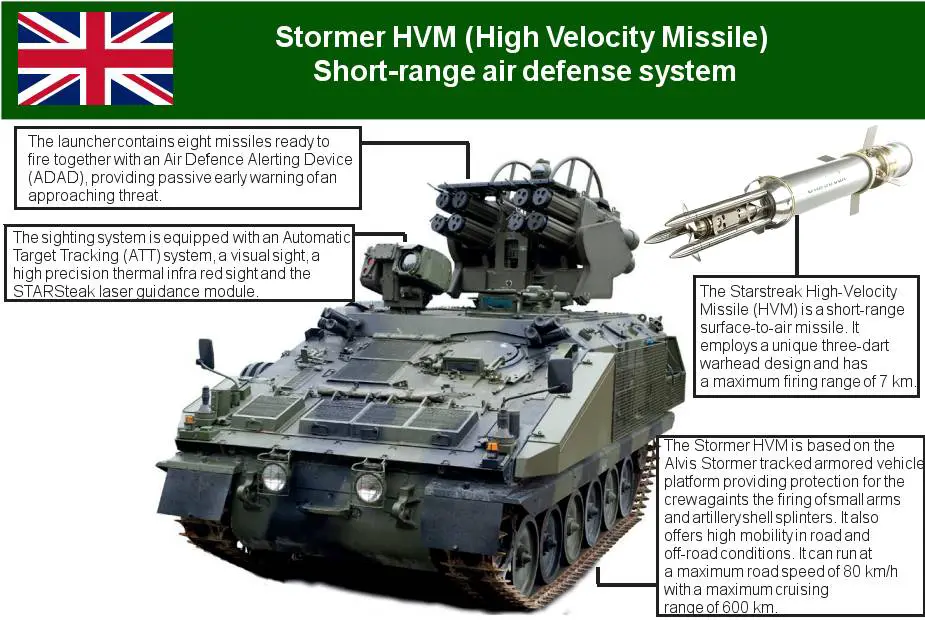 |
|
 |
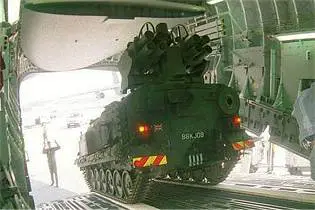 |
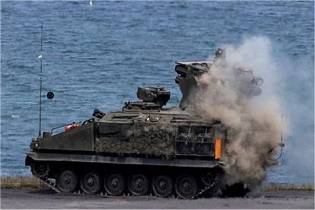 |
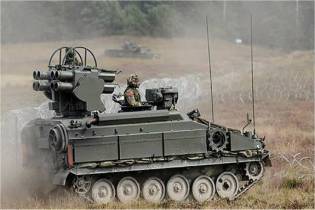 |
Pictures - Video



























